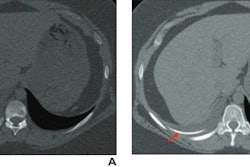AI’s impact on radiology is covered in a mostly positive light in U.S. news media, though radiologists may not be included in such coverage, researchers have reported.
A team led by Brent Little, MD, from the Mayo Clinic in Jacksonville, FL, found that in U.S. newspaper coverage, news articles over the past 25 years have discussed AI’s advantages more than potential risks. However, radiologists were “infrequently” interviewed or quoted in these articles. The findings were published July 20 in Clinical Imaging.
“It is concerning that a specific radiologist was quoted, interviewed, or mentioned in only about one-third of articles, since radiologists have a nuanced and overall positive view of the role of AI in the field, and are much more qualified to talk about the current and future roles of AI in the specialty than observers in other fields," Little told AuntMinnie.com.
Radiologists continue to investigate and debate the potential of AI to improve diagnostic accuracy and clinical workflows. While radiology departments may have their fingers on the pulse when it comes to new advances in AI, the public may not realize how the technology works or how it is used in medical settings.
A poll conducted in 2023 by Stanford University researchers found that about 35% of Americans believe that AI's uses are beneficial for products and services. Public perception of the performance and role of AI in medical imaging may be influenced by news media coverage. The researchers suggested that such influence could affect future radiology practice and impact patient acceptance of imaging results, radiology training, public funding decisions, and the medicolegal landscape.
Little and co-authors evaluated the frequency and content of U.S. media coverage on AI and radiology, including news articles published between 1998 and 2023.
The final analysis included 379 news articles, including full-length articles, news briefs, and editorials. Of these, 151 were about AI tools and products pertaining to radiology. Other articles contained information on general references to AI (n = 182), AI products and tools not pertaining to radiology (n = 23), and AI company financial news (n = 23). Of the total articles included, 154 had radiology as the primary focus.
| Sentiment of AI’s impact on radiology in U.S. news media coverage | ||
|---|---|---|
| Sentiment | All articles | Radiology-focused articles |
| Positive | 226 | 122 |
| Neutral/balanced | 103 | 25 |
| Negative | 50 | 7 |
However, the news articles were split on whether AI alone is better than AI used alongside radiologists, with 101 articles (27%) suggesting that AI is better and 75 articles (20%) suggesting that combining it with radiologists is better.
Additionally, articles with a general focus on AI more frequently presented AI as having a potentially negative impact on radiology or radiologists (33%) than those with a primary focus on radiology and AI (5%).
However, radiologists were not interviewed or quoted in 68% of the news articles (n = 258). Also, 76% of the total articles (n = 289) highlighted AI’s benefits, including improved detection of diseases, improved treatment and patient management, and assistance with radiology workload, among others. Meanwhile, 46% of the articles (n = 176) mentioned potential risks associated with AI’s use, such as potential job loss, lack of trust, and concerns related to data privacy and sharing.
Finally, the team reported that 140 of the articles mentioned imaging, but did not specify which modality, and 248 articles reported on general radiology.
The study authors called the low level of radiologist input “a missed opportunity” for more balanced coverage of AI’s role in radiology. They also suggested that addressing misperceptions of AI’s benefits and risks can improve the quality of information being relayed by news media to the public.
Little said that since general interest articles may have a larger lay audience than those specifically focusing on radiology, this media coverage may have a significant impact on public perception of AI and radiology, while not accurately reflecting radiology practice.
"In practice, AI and radiologists have a synergistic relationship and AI can be viewed as a means of increasing quality and safety," he told AuntMinnie.com. "However, some media coverage has unduly focused on an imagined superiority of AI systems and a future replacement of radiologists by AI. Radiologists observe the pitfalls and deficiencies of AI systems while appreciating the role of AI in accelerating and refining imaging diagnosis."
Little added that future work may explore public concerns and questions about the evolving role of AI in radiology, including influence on perception of quality and safety.
The full results can be found here.



















